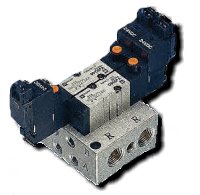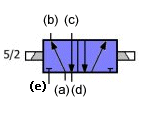Pneumatics - Valves
 To
be able to control your on-board pneumatics systems, you need to have control
valves. I found this to be one of the most bewildering areas to deal with
since there is such a huge array of different types and uses. I will try
to explain what you really need and what you can see in the catalogues
of companies such as RS, Farnell and Siebe.
To
be able to control your on-board pneumatics systems, you need to have control
valves. I found this to be one of the most bewildering areas to deal with
since there is such a huge array of different types and uses. I will try
to explain what you really need and what you can see in the catalogues
of companies such as RS, Farnell and Siebe.
The picture here is typical of the kind seen in catalogues. What this actually shows is two 5/2 ported valves seated on a manifold with solenoids fitted. But what does that mean? 5/2 ported simply means that the valve has 5 circuit points: 1x common supply (where the gas goes in), 2x outputs (which go to the cylinder you are controlling) and 2x exhausts (where the returned gas is able to escape from. The /2 means that it is a two position valve - on or off. The circuit diagram icon of a valve shows the way the connections are normally set out.
 (a)
This is the supply where the gas enters from the source.
Note: the diagram is showing the two airflow paths depending on the position
of the switch. The side I have labelled is one variation while the right
side shows the opposite. This is a bit confusing at first but does make
it easier to see what type of valve is used in a circuit.
(a)
This is the supply where the gas enters from the source.
Note: the diagram is showing the two airflow paths depending on the position
of the switch. The side I have labelled is one variation while the right
side shows the opposite. This is a bit confusing at first but does make
it easier to see what type of valve is used in a circuit.
(b) This is the initial output. This means that in position one, this output is connected to the supply and gas is flowing from the source to the device connected.
(c) This is the inital exhaust path. If this valve is connected to a double acting cylinder, then one end of cylinder is being pumped with air from (b) while the other end is venting its air back through (c). This exhaust gas is then vented back through (d).
When the valve is switched, the path is flipped so that (c) is now receiving the supply gas and (b) to (e) is now the exhaust path. So in one position your cylinder will be extended and in the other it will retract. This is the most common form of valve in robot wars. You can also get 3/2 valves, for use with single acting cylinders, and 5/3 valves. We have a 5/3 valve (5 ports and 3 positions) on More Panda Monium to allow us to lock the small lifting cylinder in position. Basically, by using resistors (a small, screw-in, adjustable exhaust) on the exhausts of the port, you can control the speed at which the gas is exhausted. The third position on the switch is a neutral position where no gas flows either way. So, the resistors slow the exhaust speed, which gives you time to move the valve to a neutral position and 'lock' the cylinder in a position. With the right resistance, we can use the non-sprung joystick on the radio transmitter to move the cylinder in or out and lock its position in the centre.
This brings us neatly to control. You need to switch the valve remotely. There are three types of valve: solenoid, manual and pilot driven. Manual is the simplest and just means a mechanical bar is moved to switch the airflow. I guess you could use this with a servo arm, but I've never tried it. Pilot means there is a small amount of the supply gas used to operate the valve. This is really for sequential operated systems. The return is often done by spring or by solenoid. Solenoids are ideal for RW. A solenoid is fitted to one or both ends of the valve and when electric current is supplied to the solenoid, it switches the valve. Return can be done by spring, air pilot or another solenoid. We have solenoid/pilot valves for the weapon and shovel and a double solenoid one the 5/3 valve. The pilot needs a minimum air pressure of about 1.5 bar to actually operate. The solenoid operates from the 24v dc supply and can be switched by servo or by solid state switches such as those available from Team Delta or Dangerous Machines.
One final thing to remember when choosing a valve is that all your air is going to go through the holes in the valve. The larger the holes, the more air can get through quickly. Make sure that you don't restrict the airflow by getting valves which are too small for the job in hand. You can also just vent the gas straight back out of the exhaust ports, but I would recomend the use of a couple of spare connectors screwed in to direct the exhaust away from the valve and to act as a quick exhaust device.